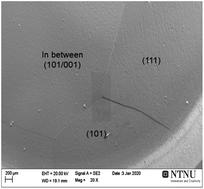当前位置:
X-MOL 学术
›
J. Anal. At. Spectrom.
›
论文详情
Our official English website, www.x-mol.net, welcomes your feedback! (Note: you will need to create a separate account there.)
Influence of polycrystalline material on crater shape optimization and roughness using low-power/low-pressure direct-current glow discharge mass spectrometry
Journal of Analytical Atomic Spectrometry ( IF 3.4 ) Pub Date : 2020-06-09 , DOI: 10.1039/d0ja00055h Gagan Paudel 1, 2, 3, 4 , Sergey Khromov 1, 2, 3, 4 , Martin Kasik 5, 6, 7 , Hans Jørgen Roven 1, 2, 3, 4 , Marisa Di Sabatino 1, 2, 3, 4
Journal of Analytical Atomic Spectrometry ( IF 3.4 ) Pub Date : 2020-06-09 , DOI: 10.1039/d0ja00055h Gagan Paudel 1, 2, 3, 4 , Sergey Khromov 1, 2, 3, 4 , Martin Kasik 5, 6, 7 , Hans Jørgen Roven 1, 2, 3, 4 , Marisa Di Sabatino 1, 2, 3, 4
Affiliation

|
Depth profiling is an attractive approach for analysis of non-homogeneous samples and layered materials. This application requires an optimum sputtered crater profile, which means a flat crater bottom with steep walls and a low roughness. It is known that discharge parameters are one of the most important factors influencing the crater shape. Hence, in the present work, different combinations of GDMS discharge current, voltage and argon flow, giving a flat crater bottom in tantalum are presented. A combination of mechanical profilometry, scanning electron microscopy and electron back scattered diffraction is used to show the contribution of grain orientation on various sputtering characteristics and crater bottom roughness. The results of the study indicate that differential sputtering is consistent at both higher and lower discharge conditions. The crater bottom roughness can be attributed to the differential sputtering of grains in polycrystalline materials.
中文翻译:

低功率/低压直流辉光放电质谱法对多晶材料对弹坑形状优化和粗糙度的影响
深度剖析是用于分析非均质样品和分层材料的一种有吸引力的方法。该应用需要最佳的溅射坑轮廓,这意味着平坦的坑底部具有陡峭的壁面和较低的粗糙度。众所周知,放电参数是影响弹坑形状的最重要因素之一。因此,在目前的工作中,提出了GDMS放电电流,电压和氩气流量的不同组合,使钽的底部凹坑平坦。机械轮廓分析,扫描电子显微镜和电子反向散射衍射的组合用于显示晶粒取向对各种溅射特性和凹坑底部粗糙度的影响。研究结果表明,在较高和较低的放电条件下,差分溅射都是一致的。
更新日期:2020-07-08
中文翻译:

低功率/低压直流辉光放电质谱法对多晶材料对弹坑形状优化和粗糙度的影响
深度剖析是用于分析非均质样品和分层材料的一种有吸引力的方法。该应用需要最佳的溅射坑轮廓,这意味着平坦的坑底部具有陡峭的壁面和较低的粗糙度。众所周知,放电参数是影响弹坑形状的最重要因素之一。因此,在目前的工作中,提出了GDMS放电电流,电压和氩气流量的不同组合,使钽的底部凹坑平坦。机械轮廓分析,扫描电子显微镜和电子反向散射衍射的组合用于显示晶粒取向对各种溅射特性和凹坑底部粗糙度的影响。研究结果表明,在较高和较低的放电条件下,差分溅射都是一致的。


























 京公网安备 11010802027423号
京公网安备 11010802027423号